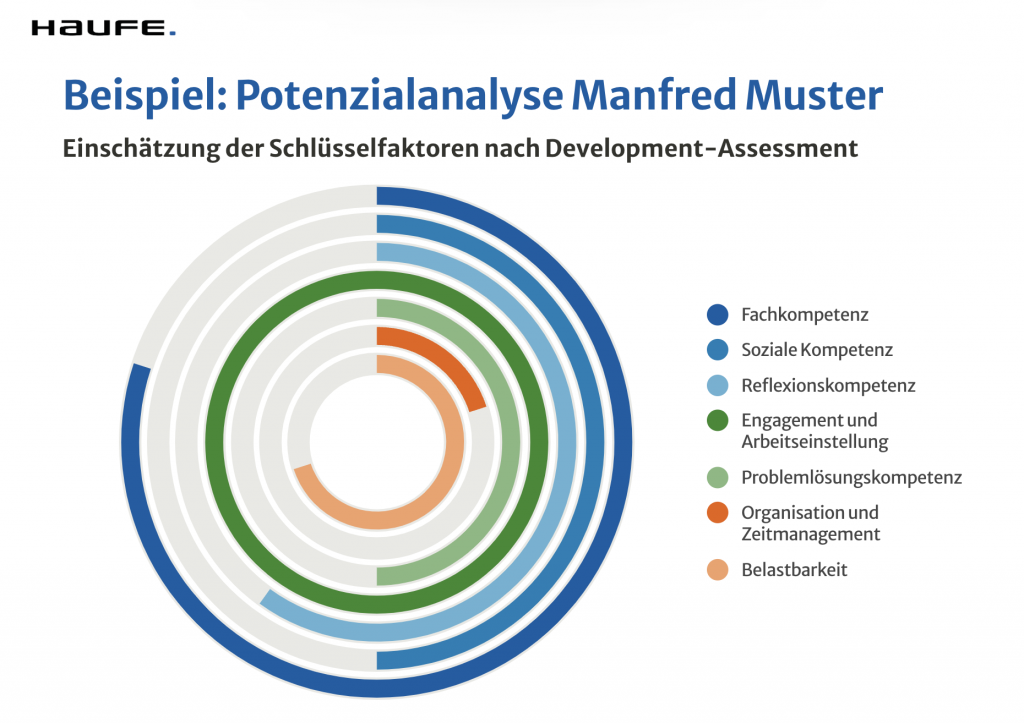A new survey by the MIT Sloan Management Review shows: The best investment companies can make to prepare for unexpected change is in their employees. Strategic Personnel Development strengthens the resilience of companies. An important tool in this context is potential analysis. In this article, you will learn how it works and how you can use it to make your employees fit for future challenges.
Definition of the term potential analysis
In human resources, potential analysis refers to the creation of an overall profile of employees. A systematic assessment is carried out on the basis of defined scales so that talents can be discovered and personnel development measures can be planned. As part of the analysis, the professional skills, motivation and personality traits of an employee are recorded, among other things. With the help of this profile, the suitability for higher-qualified tasks can be identified and targeted support is possible. The aptitude or potential profile should correspond to the requirements profile of the respective position.
Objectives of a potential analysis
The prerequisite for a successful company-wide potential analysis and promotion is a common understanding and a clear objective. Be sure to talk to company management and other key people. Goals of the company-wide potential analysis and promotion can be, for example:
- Creating an environment in which every employee can develop their potential and perform at their best. This will ensure long-term employability and performance.
- Attract, develop and retain the best employees. Through attractive development opportunities and individual career planning, managers and junior managers are recruited and specifically promoted.
- The preferential promotion of employees who are seen as having a particularly high potential to take on more responsibility. This can be technical potential as well as potential for management or project management roles.
Important: When developing and promoting potential, the requirements of the AGG must always be taken into account.
Methods of potential analysis
Assessing and promoting potential is one of the most difficult tasks in employee development. After all, the assumed potential lies in the future and cannot be observed immediately. Nevertheless, many managers secretly believe that they can assess an employee's potential for more advanced tasks "from the gut". This purely subjective evaluation is certainly not always in the company's interest. We therefore need methods and criteria that are as objective as possible for identifying potential. Without this, there is no comparability and fair promotion of potential is impossible.
The HR toolbox contains various methods for conducting a workforce analysis. This includes, for example, structured questionnaires, individual assessments, 360-degree feedback analyses and also the potential interview with the HR department:
One-on-one assessment
The behavioural or activity-oriented assessment centre is a widely used and quite mature method of assessing potential. The idea here is to confront the employee with future tasks or typical management situations and to observe them as they cope with them. However, this method is controversially discussed by experts. Therefore, the accuracy of such a potential statement should be critically questioned.
A development assessment center is used when it comes to individual managers and specific issues. This can be, for example, the question of whether a person is suitable to take on responsibility for a larger project or to set up a location abroad. The assessment is carried out by a neutral and qualified consultant and consists of several modules. The result is summarised in an expert report at the end. These modules can be part of the assessment centre:
- Structured interview on your career to date (curriculum vitae)
- Self-survey / Survey of the manager on the current performance of tasks / Performance and potential assessment
- Case studies/role plays that simulate the future leadership situation
- Personality Procedures, Personal Preferences
- Testing
The final report summarises the strengths and weaknesses, possible opportunities and threats as well as personal preferences of the respective employee. The report concludes with an assessment of potential and recommendations for further development.
Be sure to ensure transparent communication in advance and give the candidate fair and qualified feedback afterwards. This is the only way to gain motivation and trust for the measure and to maintain it in the further process. Because without trust, you cannot "leverage" even the greatest potential in the company.
This is what the short evaluation of a development assessment could look like:

360-degree feedback analytics
360-degree feedback tools are becoming more and more common. The system is based on an assessment of behaviors that are decisive for successful leadership. Assessors are not only the manager, but also colleagues, customers or suppliers as well as the person himself. Due to the different perspectives, you can receive valuable suggestions for development measures. Thanks to the comprehensive feedback, the employee is able to work specifically on his or her own further development.
The process plays a decisive role in this form of feedback: those affected must be sufficiently informed, the implementation and evaluation must be carried out professionally, and finally suitable development measures should be recommended.
Potential interview with HR
A very flexible method of reviewing a potential assessment is the potential interview with HR. Here, the potential statement of a manager can be verified on "neutral ground" with a structured interview. The advantage is that the motivation of the high-potential employee can be considered independently of the interest of the manager. Some companies also use this method when high-potential employees name themselves. This means that employees think they have potential for more responsibility, but their manager sees it differently and does not want to develop it from their current job.
The process should be deliberately installed as a way of identifying potential and should not be hidden. This way, the manager doesn't feel left out and the employee doesn't have to "secretly" ask for an interview. In order to avoid disappointment, the employee's expectations should be set correctly from the outset. You can't promise a positive potential statement, but you may be able to make development recommendations or hold out the prospect of repetition at a later date.
Conclusion: The right way to deal with potential statements counts
A potential analysis for individual employees is only effective if the identified potentials are handled correctly. Of course, this is easier said than done and basically deserves its own article. However, with transparent and open communication, you as a personnel developer can contribute to realistic expectations among the people concerned.
You can avoid frustration with identified high-potentials by regularly carrying out targeted demand planning for junior managers. In this way, you can channel the expectations of the people concerned into healthy competition and avoid promoting more junior managers than the company needs.
Open and honest feedback gives potential candidates an orientation on where they stand and what they still need to learn in order to actually get a leadership position. This is all the more important if it turns out that a person cannot or does not want to realize the presumed potential. In this case, alternative development options can be identified. Don't turn it into a "second-class career", but offer targeted orientation measures according to which employees can decide where they would most like to realize their potential.
The right expectations, open feedback and alternative career paths make potential analysis and promotion an effective means of competence and employee development and thus an essential pillar of corporate development.

Christoph Herzog
Editor: Haufe Talent
Christoph Herzog is interested in people and how they can work better together in the digital age. He is an editor at the Haufe Group, father of a daughter and likes to walk on narrow paths.




